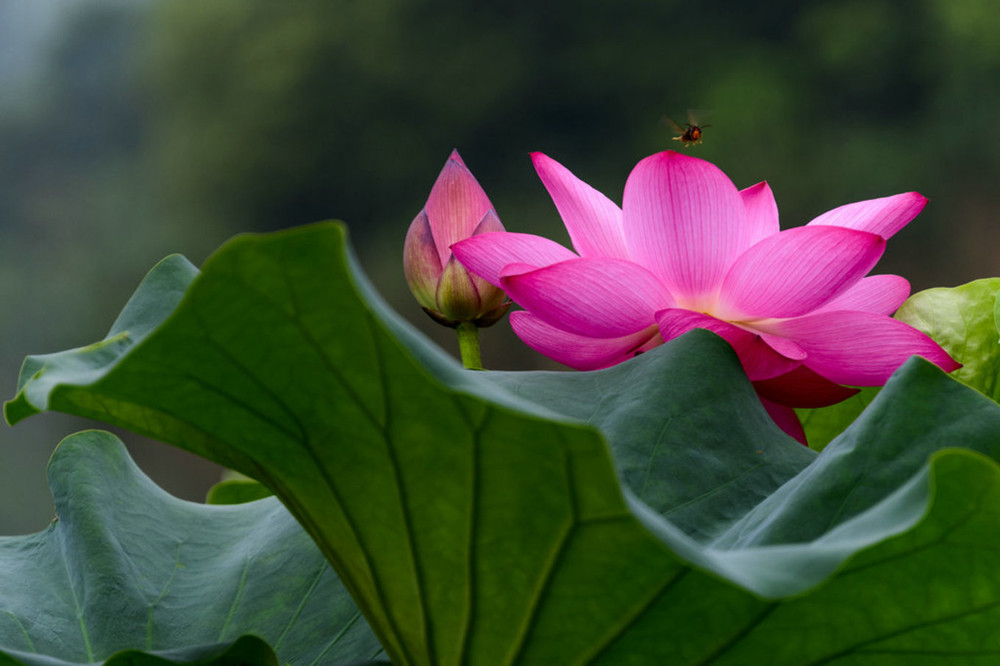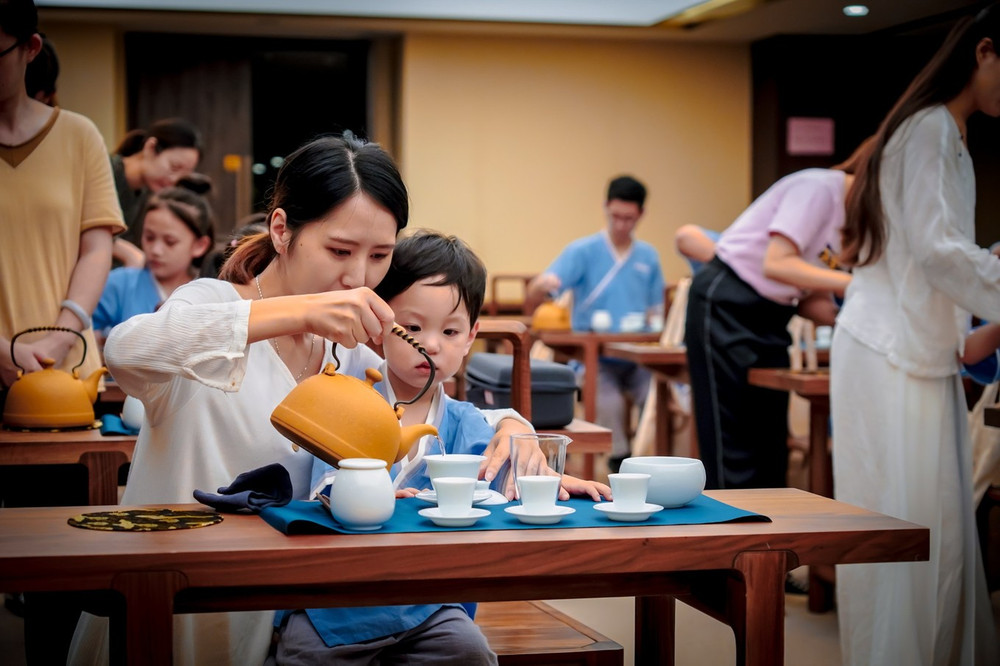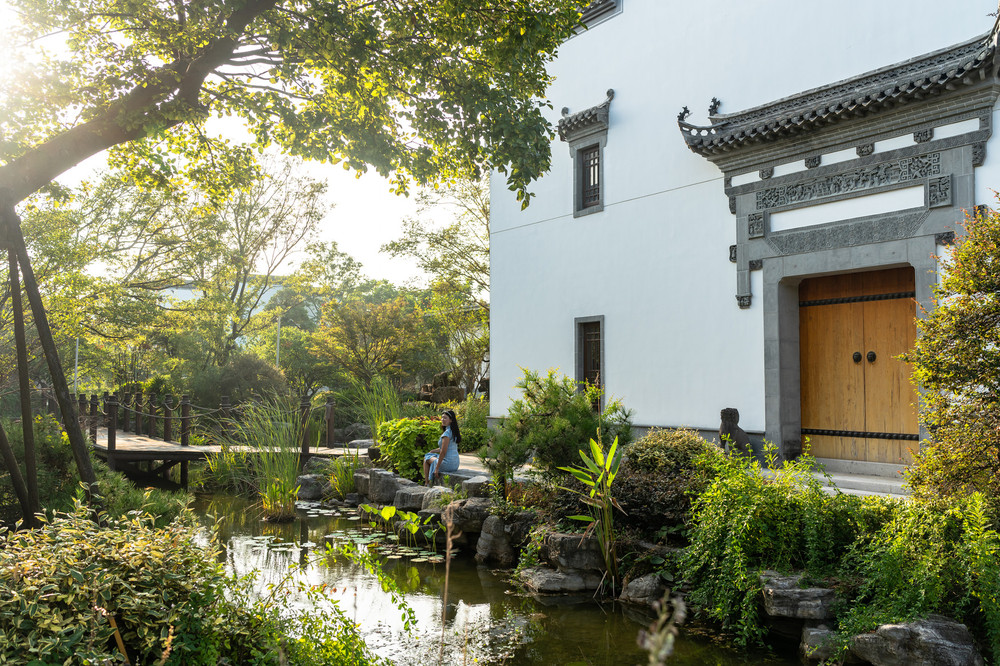**Trip Report: A Solo Lotus Viewing Adventure in Shanghai**

**Duration:** 1 day
**Time:** July
**Companions:** Solo
**Destinations Visited:** Shanghai Guyi Garden, Xinjiangwan City Park, Huangpu River, Jade Buddha Temple
**Published on:** 2020-07-27 19:19
**Summer’s Splendor: The Lotus in Full Bloom**
Summer is the season when lotuses bloom in full splendor. The endless green lotus leaves stretch to the sky, and the lotus flowers, tinged with pink and white, glow distinctly red under the sun. The lush greenery of the large lotus leaves sets off the vibrant petals of the lotus flowers, making them appear all the more delicate and fragrant. Bathed in sunlight, the lotus flowers sway gently among the sparse shadows of the leaves, with thousands of flawless white blooms emerging into the air, filling it with the subtle fragrance of the lotus.
‘A gust of wind stirs the green waves, scattering pearls that are hard to gather.’ As sunlight spreads over the water’s surface and a breeze passes, ripples form, and pearl-like droplets tremble on the delicate leaves. The lotus, belonging to the Nymphaeaceae family, is a common name for two species of water lilies. Also known as the lotus flower or water hibiscus, it is a traditional famous flower in China. Its leaves are fresh and elegant, and its fragrance permeates and refreshes the senses. It has the quality of facing the scorching sun without fear and emerging from the mud unsoiled.
**Lotus in Buddhism and Chinese Culture**
In Buddhist legends, the Western Pure Land is filled with lotus flowers. In Buddhist studies, dust represents the troubles of the world, and the lotus’s characteristic of emerging from the mud unsoiled breaks people’s attachment to troubles, guiding the soul towards eternal purity and unity. The purity of the lotus has touched the Chinese people’s pursuit of beauty, originating from its unique water-repellent cuticle structure. The spiritual symbolism of the lotus has made it beloved by the Chinese for 1500 years. Since ancient times, the lotus has been favored by literati and poets. Nowadays, it is loved by everyone and has become the theme of urban tourism and cultural festivals or lotus festivals held every summer, attracting a vast number of tourists and citizens, and providing a great place for photography enthusiasts to appreciate and photograph lotus flowers.
**The Best Time and Places to Admire the Lotus in Shanghai**
The blooming period of the lotus is from June to September (with July and August being the most beautiful), and the best times to appreciate lotus flowers are in the early morning and after the rain. When it comes to lotus appreciation, the first place that comes to mind for people in Shanghai might be the Guyi Garden, but many may not know that appreciating the elegant, wind-swaying lotus flowers in Yangpu’s Xinjiangwan City Park is also a good choice.
**A Visit to Xinjiangwan City Park**
Our original plan was to visit the Guyi Garden to see the ‘2020 Lotus and Water Lily Exhibition,’ but due to this year’s ‘violent plum rain’ and the prolonged rainy season, we missed it. So we went to the nearby ‘Yangpu Xinjiangwan City Park’ to enjoy the lotus flowers. Shanghai’s Xinjiangwan City Park is located in Xinjiangwan City, which is the former site of the Jiangwan military airfield. As a military facility, its seclusion for over sixty years has preserved the original ecological appearance of the land, with lush vegetation, crisscrossing ditches, and abundant wildlife resources. It is the only original ecological wetland in the urban area of Shanghai, named after the first major bend at the estuary of the Huangpu River.
The estuaries of the Yangtze River and the Huangpu River coincide at the former Jiangwan Airfield and surrounding areas. Jiangwan is a thousand-year-old town with 9000 acres of fertile land, with the living water of the Huangpu River flowing through it. It has a profound historical and cultural heritage; the famous general Han Shizhong of the Song Dynasty once stationed troops here, and the original site of the famous Buddhist temple, Jade Buddha Temple, is also located here. Zhu Ziqing, Ye Shengtao, and Xia Yan once founded Lida College here. Therefore, Jiangwan has been a place of merchants and a must-contest area for businesses throughout history, known as the famous ‘Copper Jiangwan.’
The park is rarely visited by tourists, offering a quiet and comfortable atmosphere, essentially a natural oxygen bar! Walking straight from the park’s main entrance, you will soon reach the water area where lotus flowers bloom. The water surface is quite broad, with a ring of steps forming a waterside platform that encircles the lake, creating a beautiful semicircle.
**Impact of the Violent Plum Rains**
Influenced by the violent plum rains and the seemingly unending plums, this year’s lotus blossoms did not fare as well. There are numerous wooden platforms, close to the water and plants. Approaching the lotus pond, the first thing that catches the eye is the boundless sea of lotus leaves, resembling a green ocean. Some leaves have only just emerged with tender tips, incredibly charming. Others have grown as large as a palm, standing tall and swaying gently in the breeze; some have become ‘large jade plates,’ full of vitality.The leaves are packed closely together, like a group of siblings with their hearts connected, intimately close. At this moment, a gust of wind blows, and the ‘green ocean’ momentarily becomes undulating waves, with leaves rolling one after another, incredibly beautiful. When the wind stops, the ‘green ocean’ calms down again. The water droplets on the leaves roll around, crystal clear, like beautiful pearls. It’s truly ‘a gust of wind stirs the green waves, pearls scattered and hard to gather.’
As the boat glides through the lotus, the blossoms display a thousand different forms. Some are just a bud with a hint of white, shy and about to bloom. Some are half-open, with petals scattered down and others clustered around the stamen, like an undressed beauty. Those fully bloomed are like young girls dancing gracefully. The lotus flowers, after their splendid blooming moment, appear again in the form of lotus pods full of fruits after their petals have fallen. The flowers have intention, and the lotus leaves fly like boats, some with petals all fallen off, revealing the bright green lotus pods. The small holes on the lotus seeds seem like little mouths, shouting loudly: ‘I am ripe, come and pick me!’
Besides the elegant lotus flowers, birds, frogs, dragonflies, and bees flit about, adding a touch of interest to the lotus pond; the pond is also full of vitality and energy because of them. The lotus emits a fresh and elegant fragrance, attracting bees to dance and play, pleasing to the eye. And those playful dragonflies, flapping their wings, fly from one flower to another, happily playing with the lotus flowers. I was intoxicated, feeling that the lotus flowers before me were graceful lotus fairies dancing.
‘The young lotus just shows its sharp tip, and dragonflies already stand on the top.’ This line comes from Yang Wanli’s ‘Small Pond’ in the Southern Song Dynasty. This poem expresses the author’s love for life, depicting a simple, natural, and full of life’s charm through the description of the spring water, shade of trees, young lotus, and dragonflies in the small pond.
‘The young lotus just shows its sharp tip, and dragonflies already stand on the top.’ Throughout the summer, dragonflies fly gracefully in the lotus pond. One flower, one world; one scene, one paradise. These beautiful dragonflies fly gracefully and freely under the blue sky, like beautiful women, displaying the charm of beauty and the brilliance of life in this summer.
‘The young lotus just shows its sharp tip, and dragonflies already stand on the top.’ Thus, the poet’s heart bursts with beautiful reverie and beautiful verses, and dragonflies fly into Tang and Song poems. In the morning and evening of June, dragonflies fly over the lotus pond, on the sharp tips of young lotus, on the bright green lotus leaves, they jump up and down, look around, touch the water with their tails, and play freely.
Dragonflies are invertebrates, arthropods, insect class, winged sub-class, dragonfly order, anisoptera sub-order, divided into dragonfly family and damselfly family. Dragonflies are among the most ancient insects, with fossils dating back over 60 million years, proving their existence on Earth for over 100 million years. They are known to have the most eyes of any insect in the world. Dragonflies’ eyes are large and bulging, occupying most of their head, with three simple eyes and compound eyes composed of about 28,000 small eyes. Their vision is excellent, and they can look up, down, forward, and backward without turning their heads. Moreover, their compound eyes can measure speed. When an object moves in front of the eyes, each ‘small eye’ responds in sequence, and after processing, the movement speed of the target object can be determined. This makes them the masters of insect predation.
Unlike many other insects, dragonflies lay their eggs in water, and their larvae live in water, which is why their ‘touching water’ is actually laying eggs. Female dragonflies lay eggs in the water, mostly by touching the water surface with their tails while flying, expelling the eggs. The common ‘dragonfly touching water’ is the performance of its egg-laying. Dragonflies are typical incomplete metamorphosis insects, which do not go through the process of pupation from nymph to adult. They only go through three stages in their lives: eggs, nymphs, and adults. Dragonfly nymphs are aquatic, while adults are terrestrial insects with flight capabilities.
Every time I read ‘The young lotus just shows its sharp tip, and there is already a dragonfly standing on it,’ I can imagine the dragonfly dancing above the lotus pond.
‘The young lotus just shows its sharp tip, and there is already a dragonfly standing on it,’ ‘The lotus leaves are boundlessThe summer’s most vibrant spot is undoubtedly the blooming lotus pond. It’s not just the beautiful lotus flowers that make it special, but also the presence of flying dragonflies. These creatures are the dancers of the pond, bringing life to the otherwise quiet lotus. With their movements, the scenery comes alive; dragonflies skimming the water’s surface create ripples, and as they land on lotus tips, the flowers sway gently. The interplay of motion and stillness composes a harmonious melody.
The dragonfly’s wings, adorned in red and yellow, contrast with the green lotus leaves and the elegant lotus flowers, creating a unique spectacle. They resemble small airplanes, exquisite and free in their flight, sometimes even hovering like helicopters. Their flying skills are remarkable, earning them titles such as ‘little overlord in the sky’ and ‘king of flying’. Capable of 180-degree turns and figure-eight maneuvers with a mere shake of their wings, they are, in my view, the best pilots and dancers among insects. Their speed is astonishing, with the ability to fly at 5 to 10 meters per second, and even reaching tens of meters per second during high-speed sprints, all while maintaining flight for extended periods. In any competition with bees and butterflies, dragonflies would undoubtedly be the champions. The song ‘Drunk in the Lotus Pond’ captures the essence of the dragonfly’s ‘light work on the water’, as they perform a water ballet that is truly charming and enchanting.
The lotus pond is also home to damselflies, which belong to the order of insects, the suborder of Zygoptera, and are collectively referred to as ‘cōng’. These petite insects, with wings folded above their backs when resting, include common species in China such as the large and small damselflies. Slender and delicate, they resemble small dragonflies but are distinct in their features. Damselflies are brightly colored carnivorous insects, characterized by their slender bodies, well-developed compound eyes, chewing mouthparts, and bristle-like antennae. Their front and hind wings are similar in shape, with the wing veins forming a square in the central chamber. Unlike dragonflies, damselflies rest with their wings extended and folded together, and all four wings are nearly the same size. Damselflies range in size from the largest, reaching 6-7cm, to the smallest, only 1.5cm. Their elegant posture, vibrant colors, and variety of wing colors make them a favorite among enthusiasts both domestically and internationally. The ‘damselfly touching water’ is a common sight, as female damselflies, like dragonflies, lay their eggs by touching the water’s surface, typically in the water itself or in aquatic plants. Some swim along water grasses to reach submerged areas and inject their eggs into the stems using their ovipositors. Since damselfly larvae live in water, most female damselflies are accustomed to resting on stones or debris by the water’s edge. Like dragonflies, male damselflies have their reproductive organs located in the abdomen, while females have theirs at the end of their abdomen, requiring them to curve their abdomens around the male’s reproductive organs during mating to facilitate the process.
In the river, a family of black water rails, consisting of one adult and four chicks, can be observed. The black water rail, scientifically known as Gallinula chloropus, is a medium-sized wading bird, predominantly black with a red bill, yellow tip, and green legs. Found worldwide, they overwinter south of the 32nd parallel north and are commonly seen in lakes, ponds, and canals. Not adept at flying, they often run a considerable distance on water before taking off. The black water rail is listed as a protected bird species in the country. Chicks are black with a small bare patch on the top of their heads that is flesh-colored, with red bills and yellow tips. Juvenile and sub-adult black water rails turn from black to grayish-white, with gray-brown upperparts, contrasting greatly with the adult’s all-black color. Their flight feathers are dark brown. Their throat is grayish-white, the chest is brownish, and the back, chest, and belly are grayish-white. Their bills are comparatively dull, lacking the red crest. Adult birds return to black coloration with a red crest. One can hope to capture more images of the other side of the lotus pond, where a single black water rail was spotted, possibly related to the family of five.
In the lotus pond, there are also spotted-billed ducks. The spotted-billed duck (scientific name: Anas poecilorhyncha) is a large duck species, similar in size to the mallard, with a body length of 50-64 cm and a weight of about 1 kilogram.Males and females have similar plumage. The upper mandible is black with a yellow tip, while the legs are orange-yellow. The face, neck side, eye area, eyebrow stripe, chin, and throat are light yellowish-white, appearing white from a distance and contrasting sharply with the darker body color.
These ducks typically inhabit freshwater lakeshores and can also be found in groups in rivers, lakes, reservoirs, bays, and coastal tidal flat salt fields. Though they have webbed toes, they rarely dive. When swimming, their tails remain exposed above the waterline. They excel at foraging, playing in the water, and mating. Known for their cleanliness, they often groom their feathers both on water and land. They also exhibit social behaviors, taking care of each other during sleep or rest. Their diet primarily consists of plants, supplemented by invertebrates and crustaceans. Their distribution spans across southeastern Siberia, eastern Mongolia, Sakhalin Island, China, North Korea, Japan, the Indochina Peninsula, Myanmar, India, Nepal, Bangladesh, and Sri Lanka.
Water striders, aquatic hemipteran insects of the family Gerridae and scientific name Aquarlus elongatus, inhabit still or slow-flowing water surfaces of streams. They have slender, lightweight bodies with short front feet for capturing prey. Their middle and hind feet are very slender, adorned with fine oily hairs that provide a waterproof function. Their body color is dark brown, and they measure about 22mm in length. Interestingly, they can survive on land for a period of time.
In the northeast corner of a platform, one can find themselves closest to the flowers and birds. Photographers, equipped with tripods and gear, often spend entire afternoons in this spot, capturing the beauty of nature and delighting in the moments they capture. Such a life, filled with peace and beauty, is indeed a pleasant thought.
Hibiscus flowers are in full bloom in the green belt. Known as Mugunghwa, hibiscus is the national flower of South Korea. It’s intriguing to wonder if the character ‘Jin’ in many South Korean names has any connection with the hibiscus. The flower language of hibiscus signifies gentle persistence. These flowers bloom in the morning and wither in the evening, each fading to prepare for an even more splendid opening the next time.
Cicadas can be found on hibiscus trees. In Henan, cicada larvae are referred to as ‘pazha’ and are considered a delicacy in regions such as Henan, Shandong, and Hebei. The main producing areas for pazha are Henan and Shandong, with an increasing demand leading to a decrease in output and a rise in price.
Lastly, the pomegranate tree is heavy with fruit, a sight of abundance and promise.









